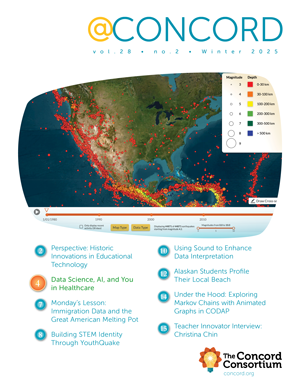Connecting Energy Across the Curriculum
The importance of energy and energy use is evident in all corners of our lives. From the food we eat to the cars we drive, energy plays a central role in our political and social lives. Similarly, energy is one of the most central ideas in science. The flow and transformation of energy ties together concepts across all disciplines.
Many existing science curricula present a disjointed view of this vital aspect of energy, however. Students encounter science and energy concepts in isolation, making it difficult or impossible for them to build an appreciation for how energy bridges topics and links ideas. New tools and integrated curriculum units developed at the University of California, Berkeley and the Concord Consortium are aimed at helping students make these critical connections.
The Cumulative Learning using Embedded Assessment Results (CLEAR) project, funded by the National Science Foundation, is studying the effects of these tools on sixth and seventh grade student understanding of energy. Topics include thermodynamics, plate tectonics, global climate change, and photosynthesis. Students are encouraged to build on their ideas about energy as they encounter the concepts in multiple activities.
The activities are presented in the Web-based Inquiry Science Environment (WISE), which provides scaffolding and embedded assessment (Figure 1). Students depict and process their understanding of energy relationships using a unique diagramming tool called MySystem being developed by the Concord Consortium and the University of California, Berkeley. An open source software tool for creating simplified systems diagrams, MySystem enables students to use icons (e.g., sun, plant, chloroplast, and more) connected by arrows to represent energy transfer and transformations within a system (Figure 2). Students can add color to the arrows to distinguish different types of energy or make the arrows wider or narrower to represent differing rates of energy flow. They can also indicate energy transformations and annotate icons and arrows to add more detailed information. For each diagram, students write a related narrative — called an Energy Story — as a written account of the energy within their system. These stories provide alternate representations to scaffold student understanding and additional artifacts for formative assessment of student learning.

Research results
Throughout the CLEAR curriculum, assessments, activities, and professional development are aligned using Knowledge Integration (KI) patterns and principles. KI is a constructivist view built upon 25 years of science education research1, 2. Teaching from a KI perspective involves eliciting and adding to students’ ideas about scientific phenomena, scaffolding the use of evidence to distinguish relevant and normatively accurate ideas from others, and helping students integrate ideas into promising explanations of scientific phenomena.
Students’ Energy Stories and MySystem diagrams from the seventh grade photosynthesis unit were scored using KI rubrics. Higher scores indicated that students made more scientifically valid links between energy ideas in their explanations. On the pre-unit Energy Story assessment, most students presented either irrelevant ideas or normative, isolated ideas without any scientifically valid links. Only a few students explained that plants create glucose using light energy or that energy is transferred from the plants to other living organisms. None of the students explained energy transformations at the molecular level. Using MySystem diagrams on the pre-unit assessment, most students provided non-normative ideas about the flow of energy in photosynthesis by connecting irrelevant objects, such as the rabbit and the sun icons.

We found significant learning gains in student understanding of the complex roles of energy in photosynthesis in their Energy Stories and MySystem diagrams. On the post-unit assessment, student narratives presented a more coherent explanation of how energy is involved in photosynthesis. Seventy percent of the students made the energy transformation link that light energy is converted into chemical energy in the chloroplast. Many students included details about the role of light energy in breaking up carbon dioxide and water molecules in their Energy Stories.
One student said:
“Plants get their energy from the sun. The sun shines down on them and breaks up the CO2 and H2O and they combine to make glucose, a basic sugar plants use to get energy.”
Another seventh grade student wrote this detailed description:
“The sun rays come into the plant and the plant’s chlorophyll absorbs the sun’s energy, water, and CO2 . The sun energy breaks down the CO2 into smaller molecules. Then the molecules combine to make oxygen and glucose. We breathe in the oxygen and breathe out CO2 which is remanufactured into oxygen again. The plant uses the glucose as food to grow. Then an animal eats it and the process starts over again.”
Students also used MySystem diagrams on the post-unit assessment to create more accurate representations of the flow of energy in photosynthesis with elaborated explanations on the arrows.

Conclusion
Our research shows that the combination of Energy Stories and MySystem diagrams gives students multiple avenues for clarifying their thinking. One teacher remarked that her students could gain a far deeper understanding of plate tectonics because they built on earlier ideas:
“I’m making sure that they understand what’s going on in our earth that drives the plates. They tell me how heat takes energy through the earth, so they’re using the information they learned in the thermodynamics unit.”
The CLEAR project is helping students make connections — the cumulative effects of studying energy concepts throughout multiple curriculum units are paying off.
Vanessa Svihla (vsvihla@hotmail.com) is a Postdoctoral Scholar at the University of California, Berkeley.
Kelly Ryoo (khryoo@berkeley.edu) is a Postdoctoral Scholar at the University of California, Berkeley.
Marcia C. Linn (mclinn@berkeley.edu) is Professor of Cognition and Development at the University of California, Berkeley.
Chad Dorsey (cdorsey@concord.org) is President of the Concord Consortium.
This material is based upon work supported by the National Science Foundation under grant DRL-0822388. Any opinions, findings, and conclusions or recommendations expressed in this material are those of the author(s) and do not necessarily reflect the views of the National Science Foundation.
